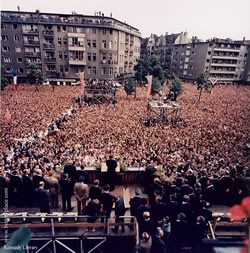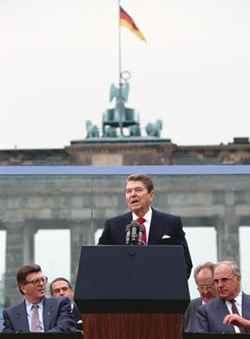Beyond Watergate: The Ford, Carter, Reagan, Bush and Clinton Years
America 1974-2001
President Gerald Ford
Upon President Nixon’s resignation, former Congressman Gerald Ford became the first unelected president of the United States. A decent and honest man, Ford had been the respected Republican minority leader in the House of Representatives. In accordance with the 25th Amendment to the Constitution, President Nixon had named Ford as vice president when Vice President Spiro T. Agnew resigned over corruption charges. President Ford soon named political veteran and former Governor Nelson Rockefeller of New York as his vice president. Thus from late 1974 through January 20, 1977, neither the president nor vice president of the United States had been elected to those offices.
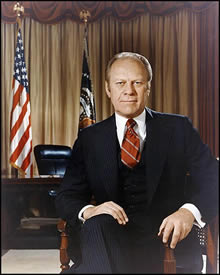 Not wishing to see the ugly spectacle of Watergate drawn out any further, President Ford decided to issue a blanket pardon to President Nixon, feeling that a trial would serve no useful purpose. A substantial public outcry greeted President Ford’s announcement. Despite the fact that the pardon cost Ford significantly in popularity, he testified before Congress that he had made “no deal, period,” in being appointed vice president and subsequently pardoning President Nixon.
Not wishing to see the ugly spectacle of Watergate drawn out any further, President Ford decided to issue a blanket pardon to President Nixon, feeling that a trial would serve no useful purpose. A substantial public outcry greeted President Ford’s announcement. Despite the fact that the pardon cost Ford significantly in popularity, he testified before Congress that he had made “no deal, period,” in being appointed vice president and subsequently pardoning President Nixon.
The end of the Vietnam War, the resignation of Richard Nixon in August, 1974, and with students back in the classrooms rather than on the streets the period known as “The Sixties” was finally over. The country settled in to await the celebration of its 200th anniversary on July 4, 1976. Some felt that the celebration became rather excessive, and a New Yorker cartoon showed an automobile on a highway as the driver and passenger looked at a sign saying, “Bicentennial-free Zone Ahead!” But the fireworks celebrations were nevertheless spectacular, and the country celebrated its 200th birthday with enthusiasm. The last quarter of the turbulent 20th century had begun.
Despite the Paris Accords, fighting continued in Vietnam, and on April 30, 1975, the Saigon government announced its unconditional surrender to the forces of North Vietnam. The capital of Saigon was soon renamed Ho Chi Minh City, and a long, painful period of readjustment began throughout the war-torn country. During the last days before the fall of Saigon, President Ford ordered American helicopters to evacuate all remaining American personnel along with several thousand Vietnamese who had been supporters of the Americans. Tens of thousands of additional Vietnamese fled the nation following the fall to the Communists, and many of them eventually made their way to the United States.
President Ford apparently intended to continue the foreign policy of President Nixon since he kept Henry Kissinger on as Secretary of State. Ford met with Soviet President Leonid Brezhnev in 1974 at Vladivostok and signed an arms control agreement designed to facilitate an arms control agreement, SALT II (Strategic Arms Limitation Treaty.) Secretary Kissinger continued to work toward a peaceful resolution of the tensions in the Middle East and helped to bring about an agreement between Egypt and Israel, who pledged not to settle future disputes through the use of force. In 1975 the United States and the Western European nations adopted what became known as the Helsinki Accords. In return for recognition of Soviet domination of Eastern Europe, the Soviet Union agreed to a policy recognizing human rights. Whether the people living under Soviet domination in Eastern Europe actually enjoyed an improvement in their human rights was never clearly demonstrated. Soviet leaders treated the accords as a diplomatic triumph.
During President Ford’s tenure a campaign finance law was passed which placed ceilings on contributions to presidential elections and required full disclosure of campaign contributions and expenditures. (The amount of money spent on presidential campaigns has nevertheless continued to increase; in the 2008 presidential election it is estimated that the parties spent approximately $1 billion in the campaign.) In the 1974 congressional elections the Democrats made significant gains in the aftermath of Watergate in both the House and Senate.
Although President Ford took steps to improve the nation’s economy, unemployment continued to rise during 1974, and the economy experienced a negative growth of -2%. In a further attempt to stimulate the economy, a tax reduction act was passed in 1975. Later in that year federal loans of over $2 billion were required to help New York City avoid bankruptcy. The national economy remained weak throughout 1976.
Although President Ford had never given any indication of a desire to run for the office of president before being appointed vice president by Richard Nixon, once in the White House he decided to seek reelection, a decision reminiscent of that of President Harry Truman. In 1976 President Ford held off a vigorous campaign for the nomination by California Governor Ronald Reagan. Former Georgia Governor Jimmy Carter emerged as the Democratic nominee from the field of seven candidates and chose Senator Walter F. Mondale of Minnesota as his running mate. Carter was elected in a very close election, winning 50.1% of the popular vote and 297 electoral votes to President Ford’s 240 votes. Democrats retained control of the Senate and the House of Representatives.
The Carter Years
President Jimmy Carter was born in Plains, Georgia, in 1924. A graduate of the United States Naval Academy, Carter entered the Navy’s nuclear submarine program under Admiral Hyman Rickover and studied nuclear physics and engineering. Carter left the Navy after seven years to take over the family business upon his father’s death. He served in the Georgia State Senate and was elected governor of the state in 1970. During his campaign for president, he ran as an outsider to the political system in Washington and promised to bring a new approach to the office of president. He promised that he would never lie to the American people.
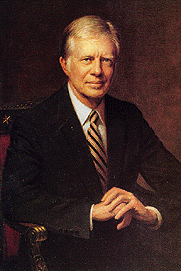 President Carter’s record as a progressive followed him to the White House. The festivities surrounding Carter’s inauguration were less formal than usual, as he and his wife Rosalynn walked along Pennsylvania Avenue following his inauguration at the Capitol. In response to a pledge made to the National Education Association, President Carter oversaw the creation of a Cabinet level Department of Education. President Carter also took initiatives to reduce domestic oil consumption and the creation of a new Department of Energy. Steps were also taken by the Carter administration to slow the rise in prices.
President Carter’s record as a progressive followed him to the White House. The festivities surrounding Carter’s inauguration were less formal than usual, as he and his wife Rosalynn walked along Pennsylvania Avenue following his inauguration at the Capitol. In response to a pledge made to the National Education Association, President Carter oversaw the creation of a Cabinet level Department of Education. President Carter also took initiatives to reduce domestic oil consumption and the creation of a new Department of Energy. Steps were also taken by the Carter administration to slow the rise in prices.
Recalling the efforts of President Woodrow Wilson, President Carter led teams to monitor elections in Latin America. He also negotiated a controversial agreement with Panama leader General Omar Torrijos. The result of the Neutrality Treaty was that all lands in the Panama Canal Zone were turned over to the nation of Panama. United States retained the permanent right to defend the canal and guaranteed that use of the canal would be open to all nations.
President Carter’s most significant foreign policy achievement, however, took place when discussions between Egypt and Israel reached an impasse. The president invited Egyptian President Anwar Sadat and Israeli Prime Minister Menachem Begin to Camp David, Maryland, where he persuaded them to stay for two weeks while disputes between the two nations were being discussed. As negotiations moved forward over the ensuing months, the president was eventually able to entertain Begin and Sadat in the White House to sign a formal peace treaty between Israel and Egypt known as the Camp David Accords.
President Carter also continued working to improve relations with China and the Soviet Union. In 1978 the United States established formal diplomatic relations with China for the first time. Shortly thereafter President Carter met with Leonid Brezhnev in Vienna to complete a new SALT II (Strategic Arms Limitation) agreement.
The presidency of Jimmy Carter was not as an effective as it might have been had the president not believed some of his own campaign rhetoric. Having promised that he would not follow the old Washington ways, he installed in the White House a number of aides from his years as governor of Georgia, the so-called “Georgia mafia.” When the president proved ineffective at dealing with Congress, House Speaker Tip O’Neill offered to assist him in working with the powerful political forces on the Hill. The president replied that as governor he had known how to work with the legislature, and if Congress was uncooperative, he would simply go over their heads to the people. He failed to realize that the interests of various sections of the country are far more diverse than those within the state of Georgia; Speaker O’Neill was surprised that the president didn’t seem to understand that basic political fact. For much of his presidency Carter’s popularity with the American people, measured by approval ratings, remained at or below 50%.
As the decade of the 1970s drew to a close the world remained an uncertain place. In 1979 Shah Mohammad Reza Palavi of Iran fled his country, and the nation was taken over by religious leader Ayatollah Ruhollah Khomeini, whose anti-Americanism was sharply defined. The United States had supported the Shah for decades, but his regime was deemed oppressive of the Iranian people, which led to his overthrow. The Shah spent several months in exile, and when it was discovered that he had cancer, he requested permission to come to the United States for treatment. President Carter eventually allowed the Shah to come to New York, but the Islamic revolutionaries in Iran demanded the Shah’s return. In addition, they made demands for the return of all the Shah’s assets supposedly hidden in the United States. The Shah eventually died in Egypt, and in protest against the United States a group of students attacked the American Embassy in Iran, captured and held 52 hostages for over a year, finally releasing them in January, 1981, on the day of President Ronald Reagan’s inauguration.
In 1979, the Soviet entered the nation of Afghanistan with a force that eventually numbered over 100,000, which President Carter denounced as a threat to world peace. The president canceled American participation in the 1980 Summer Olympic games scheduled to be held in Moscow. This struggle in Afghanistan between the Soviet army and the Afghan resistance movement, known as the mujahideen, lasted almost a decade and was considered by some to be the greatest threat to world peace since the end of the Second World War. A recent film, Charlie Wilson’s War, tells the story of a covert C.I.A. operation to provide weapons and funding to the mujahideen. Congressman Wilson of Texas traveled to Pakistan, where he was enlightened on the struggles of the Afghans against the powerful Soviet army. With the assistance of a street-wise C.I.A. operative, Wilson eventually funneled millions of dollars in aid to the mujahideen, enabling them to wear down the Soviets and drive them out of the country.
Charlie Wilson’s War, starring Tom Hanks Julia Roberts, and Philip Seymour Hoffman, was directed by Mike Nichols and written by Aaron Sorkin based on George Crile's book, Charlie Wilson's War: The Extraordinary Story of the Largest Covert Operation in History (New York: Atlantic Monthly Press, 2003.)
The Rise of Conservatism. The election of Ronald Reagan as president of the United States in 1980 was the culmination of a process that had begun in the 1950s. Following 20 years of Democratic rule in the White House under Franklin Roosevelt and Harry Truman, conservatives were prepared in 1952 to recapture the presidency. Their motto in that year was, “Time for a change.” The change, however, did not quite take the direction foreseen by conservatives, for instead of nominating Senator Robert Taft of Ohio, known at the time as “Mr. Republican,” the GOP instead nominated war hero General Dwight David Eisenhower, a moderate Republican. General Eisenhower, in fact, was so moderate that the Democrats had thought of nominating him for president in 1948 before incumbent President Truman decided to run for reelection.
Two more events in the 1950s heralded what became known as the “Reagan Revolution.” In 1955 William F. Buckley, Jr., founded the National Review, a biweekly magazine that became the mouthpiece of American conservatism. This second event, also literary, was the publication of Arizona Senator Barry Goldwater’s Conscience of a Conservative, a highly influential book among conservatives ghostwritten by Brent Bozell, brother-in-law of William F. Buckley. The book made Goldwater a star of the Republican Party and led to his nomination for president in 1964.
The motto of the 1964 Goldwater campaign was, “In your heart you know he’s right.” Goldwater’s problem was twofold, however; for many Americans Goldwater was just too far right. On top of that, the tragic death by assassination of John F. Kennedy in 1963 certainly generated a huge sympathy vote for his successor, the powerful Lyndon B. Johnson of Texas. The result was the largest political landslide in modern history, an overwhelming victory for President Johnson.
An unintended beneficiary of that campaign, however, was former Vice President Richard Nixon. He had been defeated for president in 1960 in a very close election to John F. Kennedy, and he also lost his bid for governor of California in 1962. Although Nixon had retired from the political scene, bitterly telling the press that, “you won’t have Richard Nixon to kick around anymore,” his inspiring nomination speech for Senator Goldwater in the 1964 Republican national convention gave him new political life. Nixon won the Republican nomination in 1968 and defeated Vice President Hubert Humphrey in the election.
President Nixon’s tenure in office was remarkable for a number of features. His presidency is best known for the Watergate affair, which led to his resignation in disgrace in 1974. However, President Nixon did bring America’s involvement in the Vietnam war to an end, albeit far too late for many opponents of that war. More important, perhaps, in the long run were the overtures made by President Nixon and his Secretary of State Henry Kissinger to Communist China and Soviet Russia, a process known as “détente.” On the occasion of Richard Nixon’s death in 1994, a Soviet visitor to the United States told a group of American historians that Richard Nixon was a hero in the Soviet Union because he had, in the opinion of the Russian people, made the world a safer place. The full legacy of President Nixon’s time in office has yet to be fully appreciated, though he will certainly be remembered as the only American president to have resigned the office.
President Nixon’s successor, the unelected Gerald Ford, did his best to lift the country from the political doldrums created by the Watergate scandal, but he was nevertheless defeated for the presidency by Georgia Governor Jimmy Carter in 1976. Jimmy Carter’s presidency, discussed above, was less than fully successful, and conservative former Governor Ronald Reagan of California was on hand to resurrect the conservative mantle conceived by William F. Buckley and first carried by Barry Goldwater in 1964. Thus the stage was set for what became known as the Reagan Revolution, as the conservative former governor of California took over the White House, while the nation seemed to be moving in a conservative direction.
The Reagan Years
Ronald Reagan, a successful movie actor, had begun his political career as a New Deal Democrat and admirer of Franklin Roosevelt. His movie career began in the 1950s, and he first became interested in politics during his term as president of the Screen Actors Guild. He switched to the Republican Party in 1962 and vigorously supported the Goldwater campaign in 1964. He was elected governor of California in 1966 and reelected in 1970. His tenure as governor was controversial, partly because of his tough handling of participants in the antiwar movement centered around the University of California at Berkeley. The policies he followed as governor helped to solidify his conservative views and shaped the path that he would follow when he was elected president, highlights of which were welfare reform and reduction of the influence and size of government.
The 1980 Election. For a variety of reasons, such as President Carter’s fiscal conservatism, which upset liberals, he was challenged for the Democratic nomination by Senator Edward Kennedy of Massachusetts. Although the senator showed some strength in the early primaries, he suffered from the memory of his accident at Chappaquiddick, in which a young woman in his company was drowned when his car ran off the road. Although President Carter won the nomination handily, because of the American hostage crisis in Iran he chose to campaign only in the White House Rose Garden and did not go on the stump.
Ronald Reagan had campaigned for the Republican nomination for president in 1976. He made a strong concession speech emphasizing the need for the United States to stand strong against the Soviet Union. During his 1980 campaign against Jimmy Carter he promised to follow the conservative principles of lower taxes and less government control over people’s lives. He also promised a strong national defense. With former Congressman George H. W. Bush as his running mate, the former actor and TV personality did well in television debates against the president. He won over 50% of the popular vote and carried 44 states in the Electoral College. On his inauguration day, January 20, 1981, the American hostages were released in Iran.
Reagan as President. The Chinese have a saying: “May you live in interesting times.” The phrase is often used in an ironic sense, meaning, may you find the times in which you live challenging; may you live in times of conflict and perhaps confusion; in other words, be careful what you wish for, or you might get it. The Reagan years—the 1980s—were indeed interesting. Throughout his presidency Reagan remained positive and optimistic about American society. His long years in front of television cameras made him what people called the “Great Communicator.”
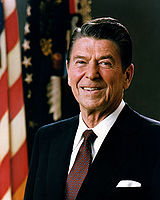 Exactly where President Ronald Reagan will wind up in the evaluation of future historians remains to be seen. One thing is clear: the fact that he presided over the beginning of the end of the Soviet Union, and therefore of the end of the Cold War, will dominate whatever is remembered about him in the past. He will no doubt be paired by some with Richard Nixon, whose presidency ended in the scandal of Watergate, but whose overtures to the Soviet Union and China undoubtedly helped make the world a safer place.
Exactly where President Ronald Reagan will wind up in the evaluation of future historians remains to be seen. One thing is clear: the fact that he presided over the beginning of the end of the Soviet Union, and therefore of the end of the Cold War, will dominate whatever is remembered about him in the past. He will no doubt be paired by some with Richard Nixon, whose presidency ended in the scandal of Watergate, but whose overtures to the Soviet Union and China undoubtedly helped make the world a safer place.
The nature of modern politics is such that public perceptions of high officeholders are shaped by the extensive media coverage that is part of our daily lives. In the early days of the republic, the vast majority of the American people never laid eyes on their political leaders. By the dawn of the 20th century, the age of automobiles and railroads was well under way, and daily or weekly newspapers were readily available to the average citizen, all of which increased contact between the president and the people. President Franklin Roosevelt was the first president to communicate with the American people on a regular basis through the use of his radio fireside chats. Television brought the public an even closer view of public figures, and as a former television figure himself, President Reagan took full advantage of the medium.
Television, however, is not the only means by which the public gains insight into the character and personality of a political leader. Radio and television talk shows as well as print columnists often provide intimate details of the inner workings of government. While President Reagan generally came across on television as competent and amiable, reports surfaced from time to time that he was not fully in touch with the issues of the day. People suggested that he invented stories and made himself a part of them, even though they had never really occurred except in his imagination. People said that as an actor, that was a natural thing for him to do. They also claimed that he was not particularly attentive in cabinet meetings, and occasionally seem to doze off even while important matters were being discussed in his presence. It was said that he merely rubber-stamped ideas and policies that were actually created by others.
President Reagan’s defenders claimed that he had a full grasp of the important issues with which he dealt and that he received too little credit for many of the original ideas that he espoused. His domestic policies were in line with the positions on which he had campaigned. In foreign policy, especially with respect to the Soviet Union, he was firm in his dedication to preserving American liberty, but he was open to negotiation and discussion with the Soviet Union and China, as well as with other nations.
Reagan’s Foreign Policy. President Reagan’s policy with regard to the Soviet Union was guided by what he called peace through strength. He continued President Carter’s policy of building up American defenses and placed intermediate-range nuclear missiles in Europe. In 1983 he announced that the United States would develop a new high-tech defense system against intercontinental ballistic missiles. The controversial Strategic Defense Initiative (SDI), known as “Star Wars,” was a plan to use space-based weapons to intercept incoming missiles. Critics felt that the program would be excessively expensive and doubted that it would be technologically feasible. Supporters argued that Reagan’s hard-nosed approach to defense strengthened his position vis-à-vis the Soviet Union.
In fact, American defense spending placed a strain on an already struggling Soviet economy. Soviet leader Mikhail Gorbachev was therefore amenable to discussions regarding reductions in strategic arms and other agreements between the two superpowers. During his second term Reagan agreed to two treaties with the Soviets that significantly reduced nuclear armaments and rendered the Soviet Union less threatening to the United States. With his motto of “trust but verify,” President Reagan promised to be fair but firm in his dealings with the Soviets. He developed friendly personal relations with Chairman Gorbachev, whose visits to the United States resulted in very favorable coverage by the media.
President Reagan’s policies toward Latin America, while not as prominent as those of U.S.—Soviet relations, still played a significant role during the 1980s. When the government of the island of Grenada in the Caribbean was taken over by a leftist political party, neighboring countries requested intervention by the U.S. President Reagan sent United States forces to Grenada to protect American citizens and students threatened by the disturbances. They soon discovered large amounts of Soviet-made Cuban weapons and remained in Grenada for about two months. Democratic elections were held a few months later. The United States also intervened in El Salvador to assist of the democratic government, though violence continued in that country for some time.
In Nicaragua the United States supported the Contras—opponents of the left-wing Sandinista government. Although Congress officially ceased providing funds to the Contras in 1984, members of the administration continued sending arms to the Contras in secret. Although a congressional investigation led to the resignation or firing of administration officials, Congress found no reason to begin impeachment hearings against the president. The investigation determined that the United States government had secretly sold arms to Iran and used part of the funds from the arms sales to support the Nicaraguan Contras. The Iran-Contra scandal kept Americans glued to the television for a number of weeks.
In 1983 a terrorist bombing in Beirut, Lebanon, killed over 200 US Marines who had been sent to the country to help support a pro-western government. In 1986 American air forces bombed targets in Libya in response to a Libyan supported series of terrorist attacks against American military personnel stationed in Europe. In the Persian Gulf U.S. naval vessels helped keep shipping lanes open by protecting convoys in the region. In Asia, the democratic government Corazón Aquino replaced the dictatorship of Philippine Ferdinand Marcos. Under American pressure, South Africa began to end its policy of apartheid.
Reagan’s Domestic Policies. Ronald Reagan will also be remembered for other things besides his highly visible interactions with Soviet leaders. His first controversial act involved his standoff with the Professional Air Traffic Controllers Organization (PATCO) who walked off the job in 1981 in an attempt to force the federal government to meet its demands for higher wages, shorter working hours and other benefits. The president responded bluntly: the strikers must return to work within 48 hours or be fired. Union members and their supporters predicted dire consequences from the President’s action—a huge slowdown in air traffic coupled with increased accidents and diminished air safety. But the air controllers’ wages were already above the national average, and the president guided a reorganization that involved reallocation of air controller resources, supplemented by the use of military air controllers. The air traffic control system was soon operating under near-normal conditions.
President Reagan was a strong advocate of supply-side economics. He believed that government stimulation of the economy through lower taxes would result in corporations increasing their investments, with resulting growth in their earnings. The increased earnings would in turn provide greater tax revenues even at lower rates. Early in his presidency he was able to achieve many of his goals, including a 25% decrease in individual tax rates. Increased defense spending in the face of the Soviet threat also stimulated the economy. Paul Volcker’s higher interest rates contributed to the reduction of the rampant inflation of the 1970s.
Nevertheless, the American economy continue to be depressed to 1982. The gross domestic product fell, and unemployment rose to nearly 10%. The early 1980s were also rough for farmers because of high costs of oil and a reduced international demand for farm goods. Conditions were especially difficult for small farmers. For a variety of reasons, however, the American economy began to recover strongly in time to contribute to President Reagan’s reelection. The economy continued its healthy growth through most of Reagan’s second term.
The 1984 Election. President Reagan defeated former Vice President Walter Mondale by a large landslide. He won every state except Mondale’s home state of Minnesota and the District of Columbia. After a tough Democratic primary fight, Mondale selected for his running mate U.S. Representative Geraldine Ferraro of New York. It was the first time a woman 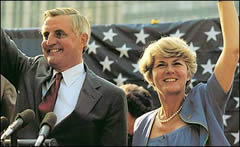 appeared on the ballot as a nominee of a major political party. Although Ferraro scored points in her debate with Republican vice presidential candidate George H.W. Bush, it is not clear whether she helped Mondale’s cause.
appeared on the ballot as a nominee of a major political party. Although Ferraro scored points in her debate with Republican vice presidential candidate George H.W. Bush, it is not clear whether she helped Mondale’s cause.
In October, 1987, the stock market took a sudden plunge, dropping almost 23% in one day. The fact that the stimulation of the economy was financed in part by deficit spending was one factor. A negative balance in American international trade and high levels of personal and public debt also were factors. Unlike the experience of the Great Depression, however, there was little permanent damage from the record single day drop in the stock market. Toward the end of President Reagan’s second term unemployment had dropped to just over 5%.
Growth of the Christian Right. Even a cursory glance at the history of religion in the Western world (and not only the Western world) will reveal that religion has always been tangled up with politics. Connections between the Holy Roman Emperors and the Pope were part of the political landscape through the Middle Ages. The division of the European world into Protestant and Catholic Christianity from the time of Martin Luther’s reformation has also been played out on the political stage. In our own immediate past, the English Reformation had a profound impact on British politics and the politics and social structure of the colonies and the emerging American nation.
Although religious issues do not seem to have been a major issue during the American Revolution, except for the fact that many patriots were bothered by the role of the Anglican Church in trying to control the colonial population, following the revolution religious issues came to the surface very soon. For example, a protracted struggle over the functioning of the United States Post Office, in particular mail deliveries on Sunday, was driven by religious factors. The social implications of the Darwinian revolution in biology in the late 19th century touched on political matters in significant ways. The 1925 Tennessee Scopes trial was but one example. The failure of New York Governor Al Smith to be elected president in 1928 was at least partially due to his Roman Catholic faith. John F. Kennedy dealt with the same issue in 1960, and although he was elected, his religion was again a factor during the campaign.
The intensity of religious feelings has tended to rise and fall in cycles over the course of American history. The late 1970s and early 1980s saw a rise in religion because many fundamentalist Christians began working to restore religion to what they saw as its rightful place within the American political structure. Baptist minister Jerry Falwell created what he called the Moral Majority, and Reverend Pat Robertson organized a group known as the Christian Coalition that was for all practical purposes an adjunct of the Republican Party.
While few people objected to the goals of reducing such things as drug abuse, prostitution and crime, critics of the religious movement objected to what they saw as infringements on First Amendment guarantees of the separation of church and state. The conflict focused over such matters as prayer in the schools and the teaching of the biblical account of creation as opposed to Darwinian evolution in science classes. Although the Supreme Court in a variety of cases struck down laws that required the teaching of creationism, or its later incarnation known as intelligent design, in science classes, the issue kept resurfacing in various parts of the country.
The Election of 1988. Prior to 1988 the last incumbent vice president to succeed to the nation’s highest office was Martin Van Buren in 1836. Vice President Bush hoped to duplicate Van Buren’s feat. The Democratic nomination seemed wide open in the early going, as eight candidates vied for the top spot on the ballot. Representative Patricia Schroeder of Colorado was an early candidate, but she dropped out before the primaries began. Other candidates included future vice presidents Al Gore and Joe Biden. The Democratic nomination went to Governor Michael Dukakis of Massachusetts. Vice President Bush selected Indiana Senator Dan Quayle as his running mate, a choice many felt did not strengthen the ticket. Nevertheless Bush won the election by a comfortable margin, taking 426 electoral votes to 111 for Dukakis.
George H.W. Bush as President. During the 1980 campaign for president George Bush had referred to Reagan’s supply-side economics as “voodoo economics.” The phrase came back to haunt him when he promised to continue the Reagan economic program. In particular, he had specifically promised during his campaign that there would be “no new taxes.” But early in his administration he ran into difficulties because of large budget deficits and a desire to introduce new legislation that would cost money. He signed legislation that strengthened environmental policies and encouraged volunteerism with the phrase “a thousand points of light.”
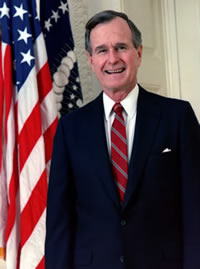 A crisis in the savings and loan industry saddled the government with huge costs as hundreds of institutions had to be shut down for insolvency. When Democrats suggested that President Bush’s 1990 budget proposal would conflict with a deficit reduction law, President Bush was finally persuaded to agree to a tax increase. Nevertheless rising expenditures for such things as healthcare kept the budget deficit growing and was a factor in the election of 1992.
A crisis in the savings and loan industry saddled the government with huge costs as hundreds of institutions had to be shut down for insolvency. When Democrats suggested that President Bush’s 1990 budget proposal would conflict with a deficit reduction law, President Bush was finally persuaded to agree to a tax increase. Nevertheless rising expenditures for such things as healthcare kept the budget deficit growing and was a factor in the election of 1992.
President Bush’s Foreign Policy. With the experiences of being director of the Central intelligence agency and vice president behind him, President Bush was well-prepared to continue overseeing progress toward the end of the Cold War. Premier Mikhail Gorbachev’s struggles with the Soviet economy revealed the weakness inherent in the Soviet system. As communist governments in the Soviet bloc broke down Gorbachev found himself challenged by hard-line Communists. Nevertheless he continued to advance his policies of economic reform called perestroika (restructuring) and increasing openness, called glasnost, to include things as freedom of the press.
President Bush met with Premier Gorbachev and helped oversee the end of the Cold War. The Berlin wall was torn down and East and West Germany were reunited in September 1990. The US and Russia—the Soviet Union no longer existed—also agreed to a reduction in nuclear weapons. The lowering of tension and the end of the period known as the “balance of terror” was offset by the fact that thousands of us who warheads existed and the threat of nuclear proliferation remained a concern to all nations. By 1991 Boris Yeltsin had gained control of the government and dissolved the Soviet Union.
The euphoria accompanying the tearing down of the Berlin wall brought to mind two famous speeches of American presidents. In 1963 President Kennedy stood before the people of Berlin and gave his famous “Ich bin ein Berliner” speech. In 1987, President Reagan, standing on practically the same spot, said, “General Secretary Gorbachev, if you seek peace, if you seek prosperity for the Soviet Union and Eastern Europe, if you seek liberalization: Come here to this gate! Mr. Gorbachev, open this gate! Mr. Gorbachev, tear down this wall!”
The end of the Cold War was not greeted with the same sort of public display of enthusiasm that accompanied the end of the Second World War. On the other hand, there was none of the bitterness that accompanied the end of America’s involvement in Vietnam, the only real high point of which had been the return of America’s prisoners of war from Hanoi. True, there was much excitement as German citizens and others smashed the Berlin wall to pieces, and certainly there were great feelings of relief among those who were now free to travel unimpeded into places that had been closed to them for decades.
Some American commentators were bothered by the fact that too few Americans seemed to know what had really been achieved. Having come through the time when the “balance of terror” never burst into a nuclear holocaust, Americans should have been on their knees thanking God or good fortune that the feared balloon had never gone up. Instead of celebrations, there was much somber reflection. As one historian wrote, “It is not certain that the United States won the Cold War. … It was Gorbachev and the East Europeans themselves, not the Americans, who rolled back the iron curtain and ended the cold war.”
Another commentator was skeptical on the unalloyed joy over the end of the Cold War. He claimed that the America foreign policy establishment was “stupefied by the pace of events … clinging to the remains of an obsolete strategy and incapable of defining a new one.” The End of the Cold War did call for a reevaluation of America’s role in the world. Soon enough, it would become apparent that forces still existed in the world capable to inflicting terrible casualties on other nations, whether or not they possessed “weapons of mass destruction,” a term that would emerge later in our history. The essential truth of the end of the Cold War remains the fact that thousands of nuclear weapons still exist, and it will require the most diligent application of the intelligence resources of the international community to prevent an act of nuclear terrorism.
|
|||||||||
Desert Storm. Focus on the end of the Cold War was diverted by the invasion of Kuwait conducted by Saddam Hussein’s Iraqi army in August, 1990. Iran and Iraq had been at war with each other throughout much of the 1980s, and the United States had generally maintained favorable relations with Iraq. The invasion of Kuwait, which was seen as a threat to Saudi Arabia, change the situation. A special session of the United Nations resulted in a series of resolutions condemning the Iraqi action and authorizing military responses.
President Bush called upon other nations to join in a coalition in preparation for driving in Iraq out of Kuwait. The president began dispatching thousands of American troops to Saudi Arabia in an operation called Desert Shield. The presence of American troops on Arabian soil raised issues with historic roots. When asked by an American news man how the Saudi government was dealing with the thousands of Americans in his nation, he responded that his government was trying to convince the Saudi people that the Americans were not crusaders. The significance of his reference to an event that had happened centuries earlier was lost on most Americans.
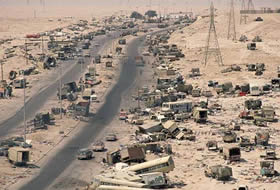 The issue of the deployment of American troops in combat was vigorously debated in Congress. Early in 1991 they passed a resolution authorizing President Bush to use armed force to restore Kuwaiti independence. American commanders skillfully planned an operation that resulted in the swift destruction of Iraqi forces, driving them out of Kuwait. Within a few days of the opening battles, President Bush declared that the objective of the war, to free Kuwait, had been achieved, and the fighting was halted. Saddam Hussein, however, was still in power, a fact that the next President George Bush would have to deal with. His repression of the Kurds in Northern Iraq and Shiites in the South and his defiance of the United Nations would lead to another confrontation a decade later.
The issue of the deployment of American troops in combat was vigorously debated in Congress. Early in 1991 they passed a resolution authorizing President Bush to use armed force to restore Kuwaiti independence. American commanders skillfully planned an operation that resulted in the swift destruction of Iraqi forces, driving them out of Kuwait. Within a few days of the opening battles, President Bush declared that the objective of the war, to free Kuwait, had been achieved, and the fighting was halted. Saddam Hussein, however, was still in power, a fact that the next President George Bush would have to deal with. His repression of the Kurds in Northern Iraq and Shiites in the South and his defiance of the United Nations would lead to another confrontation a decade later.
President Bush also worked to reduce tension in the Middle East, overseeing the signing of an agreement between Israel and the Palestine Liberation Organization at the White House in September, 1993. He also ordered the invasion of Panama and the seizure of General Manuel Noriega as part of his war on drugs. Noriega was later tried and convicted of drug trafficking in a U.S. Federal Court in Florida.
President Bush also negotiated the North America Free Trade Agreement (NAFTA) with Mexico and Canada, later ratified during the Clinton Administration.
The 1992 Election. President Bush’s promise not to raise taxes, a pledge he was unable to keep, hurt him with conservatives, who supported columnist Pat Buchanan, but he was nevertheless re-nominated for a second term. Once again the Democratic Party primary field produced a number of candidates, including Senators Tom Harkin, Paul Tsongas, and Bob Kerrey and former California Governor Jerry Brown. Governor Bill Clinton of Arkansas, a persuasive speaker who was little known outside the South before the primaries began, started slowly. But he won almost all the primaries on “Super Tuesday” in March, and continued winning through the New York and California primaries, ensuring his nomination before the Democratic National Convention met in New York City. He selected Senator Albert Gore of Tennessee as his running mate.
An interesting third party candidate appeared in the form of billionaire Texan Ross Perot, Campaigning strongly on economic issues, he showed surprising strength early, outpolling the major party candidates at times. For obscure reasons, however, he dropped out of the race, and when he reentered he had lost considerable ground. Interestingly, when it looked as though Perot might be a significant factor in the race, perhaps winning electoral votes in his home state of Texas, and in Florida, where he was popular with seniors, attention became focused on the Electoral College.
If Perot had won enough votes to deny any candidate a majority in the Electoral College, the election would have been thrown into the House of Representatives. Under the Constitution, each state would then have received one vote, which obviously could have distorted the results almost beyond recognition. Congressman, not restricted by the popular vote in their home states, would have been free to vote for the candidate of their choice, presumably members of their own party. Before Perot dropped out, two senators introduced a resolution calling for revision or even abolishment of the Electoral College, but after Perot dropped out, the issue faded.
Governor Clinton had never seen military service and had participated in protests against the Vietnam War, but he patterned his campaign after that of President John Kennedy. His policies appealed to liberal voters, and his wife, Hillary Rodham Clinton, also an effective public figure, was deemed an asset to the governor. He claimed that by voting for him, the American people would get “two for one,” meaning the president and his wife. Although Governor Clinton received only 43% of the popular vote he won a clear majority in the Electoral College, taking 370 votes to Bush’s 168. Candidate Perot took no electoral votes, although he won 19% of the popular vote, the best showing since Theodore Roosevelt in 1912.
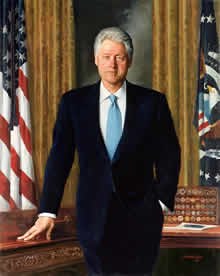 President Clinton’s term in the White House had a rough start. His first act was to change the policy of dismissing known gays in the military service. Republicans, the military establishment, and large numbers of Americans issued sharp criticisms of the move. His next move was to appoint his wife Hillary Clinton as chair of the task force to develop a national health care plan. Members of the task force provided a variety of views, which resulted in a complex plan that generated considerable debate in Congress. Because it was seen as unduly complicated, the plan never reached the floor of either house of Congress and died quietly.
President Clinton’s term in the White House had a rough start. His first act was to change the policy of dismissing known gays in the military service. Republicans, the military establishment, and large numbers of Americans issued sharp criticisms of the move. His next move was to appoint his wife Hillary Clinton as chair of the task force to develop a national health care plan. Members of the task force provided a variety of views, which resulted in a complex plan that generated considerable debate in Congress. Because it was seen as unduly complicated, the plan never reached the floor of either house of Congress and died quietly.
President Clinton was far more effective in getting Congress to ratify the NAFTA treaty. He also pushed policies fostering more liberal international trading conditions, to be overseen by the World Trade Organization. He also supported a tax bill that called for a moderate general rise in taxes and higher tax rates on people with larger incomes. The bill narrowly passed in the House of Representatives. Reactions to the president’s policies, however, invigorated Republicans, who took control of the House of Representatives in the off year elections of 1994. For the first time since 1952 Republicans controlled both houses of Congress.
The Election of 1996. America’s economy turned strong as the 1996 election neared, with unemployment dropping below 4%. Senate Republican leader Robert Dole and his running mate Jack Kemp failed to generate much enthusiasm, and President Clinton easily won reelection. Like many presidents before him, however, President Clinton would find his second term to be a rockier ride than his first.
(The Electoral College was still under discussion in 1996. If slightly more then one percent of the popular vote had been shifted to various states with larger number of electoral votes, Robert Dole could have won the election with 42% of the popular vote compared with 48% for President Clinton. Al Gore apparently won more popular votes in the 2000 election than George W. Bush, but the margin was so small as to be statistically insignificant.)
Clinton’s Foreign Policy. Much of President Clinton’s second administration was involved with foreign policy. In the post-Cold War era, the country of Yugoslavia had broken up into separate political entities: Croatia, Bosnia, Serbia, Herzegovina, Macedonia, Montenegro, and Slovenia. Ethnically, linguistically and religiously diverse, the region had a history of internal conflict. Serbian leader Slobodan Milosevic had risen to power and promised to protect the Serbian population in the Serbian region of Kosovo. Milosevic attempted to unify the entire region under Serbian dominance, which led to resistance among different ethnic groups. United States involvement included the placement of peacekeeping forces on the ground in Bosnia, as well as bombing campaign supported by NATO to end Serbian ethnic cleansing in Kosovo. Despite continuing tension between Muslim and Christian groups of varying ethnicities, a fragile peace has persisted.
During the waning days of the Bush administration American troops were sent in to Somalia as part of a peacekeeping force that would allow United Nations units to bring food to a population that was suffering starvation. While attempting to capture a warlord an American helicopter was shot down and 18 American soldiers were killed. The Americans pulled out of Somalia, but it later became apparent that an organization named Al Qaeda had supported the warlord, whose leader, Osama bin Laden, came to believe that Americans would not fight if attacked.
Other terrorist activities included an attack on a military housing area in Saudi Arabia and an explosion in the World Trade Center in New York City. Also in 1993 a federal building in Oklahoma City was bombed by Timothy McVeigh and Terry Nichols, two former military men who were radical extremists. In 1998 American embassies in Kenya and Tanzania were bombed, and hundreds more people were killed and injured. A U.S. Navy destroyer was attacked in Yemen in October, 2000, killing 17 sailors. The terrorist actions were all omens of bolder attacks to follow, but American responses to these events was limited to airstrikes.
The Economy of the 1990s. Despite disturbing events in the international arena, Americans in the 1990s enjoyed a time of economic prosperity. The economically troubled period of the 1970s led to reforms in the way American business was conducted. Companies adopted new technology and worked to reduce labor costs. Some companies took advantage of cheaper labor costs outside the United States. The growth of computers and communications devices generated new jobs in these high technology industries. From the 1980s to the year 2000 the overall economic production of the United States increased between 300 and 400%. Inflation remained low, and the stock market rose approximately 1000% between 1980 and 2000. In 1998 the federal budget achieved its highest surplus in 30 years.
Although President Clinton’s popularity remained high, he nevertheless became embroiled in a controversy over his relationship with a young intern named Monica Lewinsky. The inappropriate relationship, about which the president lied to the American people, led to his impeachment, the first time an American president was required to stand trial since President Johnson in 1968. There was little question, however, that the president would be convicted by the Senate and removed from office. Although Americans did not approve of his actions, the general feeling among the people was that while inappropriate, President Clinton’s behavior was a private matter. As long as he retained the support of his wife, people were willing to let it pass. Bill Clinton ended his presidency with his public approval ratings as high as they had been throughout his term of office.
The Election of 2000. The vast network of public and personal computers upon which millions of people relied, along with the complicated communication and transportation systems that depended on those computers, the approach of the turn from the year 1999 to the year 2000 filled many with anxiety. A great deal of energy was expended in preparation for the advance of Y2K, as the millennial change was called. In the event, the new year of 2000 was rung in with no significant setbacks from the change of date.
The election of 2000 was another matter. Vice president Al Gore won the Democratic nomination and selected as his running mate Senator Joe Lieberman of Connecticut. The Republican candidate was Texas Governor George W. Bush, son of the former president. His vice presidential running mate was former Congressmen Dick Cheney. The election turned out to be one of the most controversial in American history.
The trouble began on election night when television stations erroneously reported that Governor Bush had won the state of Florida, thereby giving him victory in the election. For about an hour very early in the morning following election day, many thought the election was over and turned off their television sets. It soon developed, however, that the vote in Florida was too close to call, and the results of the election remained in limbo. The entire focus remained on the state of Florida, whose complicated ballots had caused problems for thousands of voters.
Over the course of the next few weeks political leaders, campaign workers, and judges attempted to untangle the mess and determine the rightful winner of Florida’s electoral votes. Eventually the case reached the Supreme Court which, in a controversial decision, declared Bush the winner, the votes coming along strict party lines. A Florida newspaper later conducted a separate investigation and concluded that President Bush had indeed won Florida, but charges of a stolen election continued to hang in the air.
As President Bush settled in to his administration, the evidence of terrorist activity over the previous decade did not prepare the administration nor the American people for the shock that was about to come. On September 11, 2001, the world was shocked when four airliners commandeered by terrorists were directed against targets in the United States. Two planes struck and destroyed the World Trade Center towers in New York City. A third airliner crashed into the Pentagon in Washington, and a fourth crashed in Pennsylvania when the passengers overpowered the terrorist pilots and brought the plane down.
The experience of 9/11, as it came to be known, changed the country permanently. Transportation and communication security became the focal point of means designed to prevent further attacks. Believing that the country of Iraq was connected with the terrorist acts, President Bush ordered an invasion of the country and the removal of Saddam Hussein. When Afghanistan was determined to be the source of the Al Qaeda attacks on the United States, American troops were also introduced into that country. Both wars continue, and the threat of terrorism remains the most vital topic of consideration for most Americans.
| Postwar Domestic Home | Updated November 8, 2016 |
